The International Workshop for the Conservation and Restoration of Earthen Architecture and Urban Landscapes will be held in Chihuahua, Mexico October 12-14, 2005. For more information, download the workshop information brief: [ Español | English ]
IV SIACOT / III SEMIN¡RIO
O 4? Seminário Ibero-Americano de Construção com Terra e 3? Seminário de Arquitectura de Terra em Portugal, Convento da Orada, Monsaraz, Portugal, 7 > 12 Outubro 2005, reunirá mais de 300 especialistas na área, e terá como principais objectivos: contribuir para a melhoria na qualidade de construção e protecção do património; preparar mais adequadamente técnicos nacionais, regionais e locais a intervirem com maior conhecimento e responsabilidade no património em terra urbano e rural, assim como em áreas protegidas; aprofundar a investigação, logo contribuir para um desenvolvimento local mais sustentável, por meio de um maior conhecimento da conservação do património, da difusão de arquitectura contempor‚nea utilizando materiais tradicionais, da utilização de materiais com maior eficiÍncia energética, assim como de estratégias para formação local, com maior integração social.
Seminario Taller Sobre Construcciones con Tierra
La Red EcoSur y el Centro de Estudios de Construcción y Arquitectura Tropical (CECAT) de la Ciudad Universitaria José Antonio Echeverría (CUJAE), invitan a participar del Seminario Taller Sobre Construcciones con Tierra, el 11 y 12 de noviembre de 2005, como parte indisoluble de la III Conferencia Internacional de EcoMateriales 2005, y previo a ella, se desarrollará en La Habana Cuba este Seminario
Modern Earth Building 2005
The Modern Earth Building 2005 International Conference, to be held November 18 to 20 in Berlin Germany, has released the conference schedule. [ download ]
Gobi Adobe
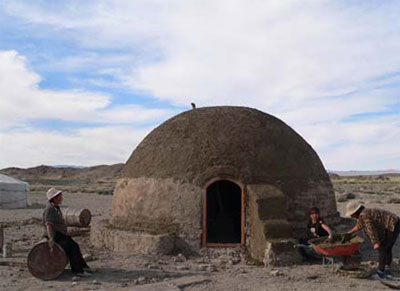
A father and son team, Basanta and Nripal Adhikary from Nepal, are reintroducing adobe in the Gobi Desert as means to provide housing in an environment where there is little timber. [ read article | construction photos ]
PROYECTO TERRA URUGUAY
Este Boletín de la Unidad Regional de Estudios y Gestión del Hábitat, quiere ser un lugar de encuentro entre todos los que estamos diseñando y construyendo Arquitecturas de Tierra. Vamos a dialogar con las casas de tierra que hoy se construyen en la región. Queremos pensar juntos en las posibilidades futuras de la tierra, reflexionar sobre ese patrimonio intangible del cual nos queda poco y evaluar este presente de la construcción con tierra.
Vineyard Residence
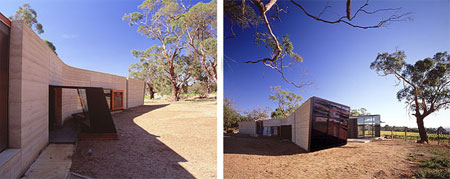
The Vineyard Residence, by John Wardle Architects, combines rammed earth with heavy timber framing and slim steelwork in the palette of materials. The design was awarded best residential building by the Royal Australian Institute of Architects.
Adobe: Building and Living With Earth
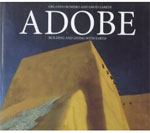
Adobe: Building and Living With Earth by Orlando Romero and David Larkin, is a picture-rich study of the history, technology, and dignified, sculptural beauty of adobe structures. The oldest of building materials, adobe bricks are made from mud and straw and have been used in Africa, the Iberian peninsula, and all across the Southwest and Mexico. Surprisingly durable if maintained, adobe constructions can last for centuries. Romero and Larkin explain brick-making and remudding techniques, showing both archival photographs of Native Americans at work on their pueblos and photographs of contemporary builders. They also document some of the Southwest’s most famous adobe churches and pueblos, such as the San Francisco Mission Church at Ranchos de Taos and the wondrous mesa-crowning Acoma Pueblo, as well as a selection of lesser-known buildings. Special attention is paid to interior decorative detail and to adobe’s intrinsic connection to the landscape.
Buildings of Earth and Straw
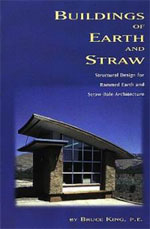
Buildings of Earth and Straw: Structural Design for Rammed Earth and Straw Bale Architecture by Bruce King chronicles the possibilities and realities of straw bale and rammed earth construction. Buildings of Earth and Straw fills in the gaps for professional builders, contractors, engineers, inspectors, lenders, and architectural students. It includes special construction requirements of earth and straw, design capabilities and limitations of these materials, and documentation of testing data for use in addressing the concerns of officials. This book offers the nuts and bolts of rammed earth and straw bale building techniques, and why they are so spectacular, durable, and earth-friendly.
The Earth Construction Handbook
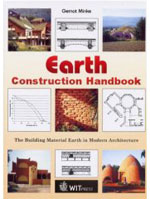
The Earth Construction Handbook by Gernot Minke provides a survey of applications and construction techniques, including physical data, and explains the materials specific qualities together with the possibilities of optimising these. The information given can be practically applied by engineers, architects, builders, planners, craftsmen and laymen who wish to construct cost-effective buildings which provide a healthy, balanced indoor climate.
